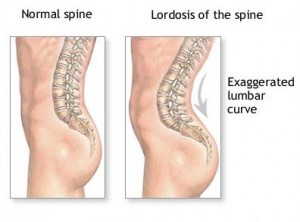 The lower spine is supposed to have a small curve (lordosis). This curve in the lower back, referred to as lordosis, allows the spine to be held upright over the pelvis and legs.
The lower spine is supposed to have a small curve (lordosis). This curve in the lower back, referred to as lordosis, allows the spine to be held upright over the pelvis and legs.
The lumbar spine also bears and transfers weight from the upper body to the lower body. If the lower spine is flat or rounded in the wrong direction, the upper body will have trouble coexisting with the lower body.
If someone has an excessive curve, known as hyperlordosis or excessive lordosis, weight transfer and support will be less efficient. The curve of the lumbar spine is designed to be minimal and maintained with muscular support from the trunk.
The key is that there is a curve, and in my opinion, the smaller the curve, the more successful the weight transfer will be.
I have found two common perceptions in the clients and students that I work with.
- Most people don’t think that they tuck their pelvis.
- Many people think they have too much lordosis.
Any reader of this blog knows that I think too many people tuck their pelvis under to the detriment of our movement patterns, our standing posture, and core tone.
It is my take that many people who perceive themselves as hyperlordotic tuck their pelvis to correct a problem from the wrong direction.
I’m not saying people don’t have lower back and pelvic issues to deal with; it is that I think most people take an upside-down approach to dealing with these problems.
It doesn’t help that conventional wisdom tells people to do exactly what I warn against—tucking the pelvis under to bring length to the lower back is recommended by yoga teachers, physical therapists, and others. I just can’t fathom why.
Please stop and answer a simple question: if you have an excessively curved lower spine, why not fix and lengthen the excessive lordosis from above the pelvis instead of by tucking the pelvis?
An untucked, or neutral, pelvis allows your gluteus maximus to be completely relaxed when standing and the big butt muscle is lifted off of the back of the thigh where it habitually resides.
Once you have found this neutral pelvis try to engage your pelvic floor and transverse abdominis without engaging your butt or tucking your pelvis.
This should extend the lower spine as you bring balance to the front and back of the body between the pelvis and the ribcage. If the length of your belly matches the length of your back and your pelvis is untucked, your lower back should be extended in a proper curve.
This often begs the question: “Do I have to walk around with my stomach engaged all the time?” The answer is a resounding no, but if someone lacks core tone, working this way for a short time can help you get the ball rolling.
The danger of living with engaged abdominal muscles is that they can easily interfere with natural breathing processes.
This is where core work comes into play. Your body will not become balanced by osmosis. You have to figure out the muscles that need shortening (the front of the body) and the muscles that need lengthening (the back of the body), and do specific exercises to make that happen.
Only then can you start to figure out the correct curves of the spine. But you won’t figure it out by tucking your pelvis.
***
